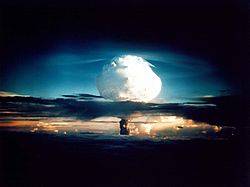Operation Ivy (nuclear test)
|
Nuclear test Operation ivy
|
|
|---|---|
 Ivy Mike nuclear test |
|
| information | |
| nation |
|
| Test location | Eniwetok Atoll |
| Period | October – November 1952 |
| Number of tests | 2 |
| Test type | Above-ground tests |
| Weapon type | Fusion (Mike) Fission (King) |
| Max. Explosive force | 10.4 MT |
| navigation | |
| Previous test | Operation tumbler snapper |
| Next test | Operation Upshot Knothole |
When Operation Ivy (ivy English for Ivy ) were two American nuclear testing referred Ivy Mike and Ivy King . Both tests were carried out by Joint Task Force 132 in the Pacific on Eniwetok Atoll in 1952 .
The previous series of nuclear weapons tests was Operation Tumbler-Snapper , the subsequent Upshot-Knothole .
The individual tests of Operation Ivy
Ivy Mike
→ Main article: Ivy Mike
Ivy Mike was the first hydrogen bomb and had an explosive force of 10.4 megatons TNT equivalent . The bomb was detonated because of its weight on the ground. Ivy Mike was the fourth largest atomic bomb tested by the US. The island of Elugelab disappeared completely, the surrounding islands were destroyed by the fireball and the pressure waves up to 10 kilometers away. Instead of the island of Elugelab, there was a crater in the reef, over 3 kilometers in diameter and 60 meters deep. A total of around 80 million tons of earth were thrown up.
Ivy King
Ivy King was a smaller nuclear weapon that was dropped from an airplane. Although it was not a hydrogen bomb (i.e. no nuclear fusion took place), an explosive force of 500 kilotons was achieved. This made Ivy King very strong for its design. King was detonated because the US military demanded a large nuclear fission bomb as the success of the developed hydrogen bomb Mike was uncertain. France later optimized pure nuclear fission bombs up to 800 kT, which is probably the maximum.
| bomb | Date / Time ( GMT ) | place | Explosion height | Test type | Explosive force (predicted) | Remarks |
|---|---|---|---|---|---|---|
| Mike | October 31, 1952 7:14 p.m. |
Elugelab Island | 3 meter | Surface test | 10.4 MT | First thermonuclear nuclear weapon |
| King | November 15, 1952 11:30 p.m. |
Runit Island | 450 meters (1480 feet) |
Dropped from a B-36H bomber | 500 kT | Largest and most powerful nuclear fission-only bomb detonated by the United States; Prototype for the Mark 18 bomb |
See also
Web links
- Ivy Mike ( Memento from July 12, 2007 in the Internet Archive )
- Operation Ivy on nuclearweaponarchive.org
- Operation Ivy - Department of Defense video
- Declassified US Nuclear Test Film - Operation Ivy on YouTube .com
Individual evidence
- ↑ US Department of Energy, Nevada Operations Office: United States Nuclear Tests, July 1945 through September 1992 , DOE / NV - 209-REV 15, December 2000, (PDF, 877 kB) ( Memento from October 12, 2006 in the Internet Archive )
- ^ Robert Standish Norris, Thomas B. Cochran: United States nuclear tests, July 1945 to 31 December 1992 (NWD 94-1) , Nuclear Weapons Databook Working Paper, Washington, DC: Natural Resources Defense Council, February 1, 1994, (PDF , 4.26 MB) ( Memento from October 12, 2006 in the Internet Archive )
- ^ Gallery of US Nuclear Tests ( memento August 20, 2009 in the Internet Archive ) at nuclearweaponarchive.org
- ↑ The ignition was at 7:15 a.m. on November 1, 1952 local time (see Analysis of Radiation Exposure for Naval Personnel at Operation IVY ( Memento of February 5, 2009 in the Internet Archive ) Report on behalf of the DNA , 1983 ( pdf , English ; 905 kB)) as this according to both the but world time than usual at the US military ZULU time was also on October 31, this date is used for ignition.
- ↑ Nuclear Test Personnel Review (NTPR) Program, Operation IVY Fact Sheet ( Memento of February 18, 2013 in the Internet Archive )
- ↑ a b Michael Light: 100 Suns , 2003
